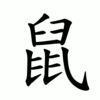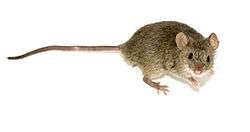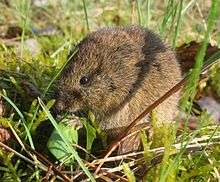鼠
| ||||||||
Translingual
| Stroke order | |||
|---|---|---|---|
 | |||
Han character
鼠 (radical 208, 鼠+0, 13 strokes, cangjie input 竹X女卜女 (HXVYV), four-corner 77717, composition ⿱臼⿲⿺𠄌⺀⿺𠄌⺀㇂(GJK) or ⿱臼⿲⿺𠄌𠄠⿺𠄌𠄠㇂(HT))
- Kangxi radical #208, ⿏.
Derived characters
- Index:Chinese radical/鼠
- 𠏙, 𦡔, 𣜌, 𤢡, 𥣅, 𧒑, 𨭿
References
- KangXi: page 1527, character 14
- Dai Kanwa Jiten: character 48390
- Dae Jaweon: page 2063, character 23
- Hanyu Da Zidian: volume 7, page 4772, character 1
- Unihan data for U+9F20
Chinese
| simp. and trad. |
鼠 | |
|---|---|---|
Glyph origin
| Historical forms of the character 鼠 | ||
|---|---|---|
| Shang | Shuowen Jiezi (compiled in Han) | Liushutong (compiled in Ming) |
| Oracle bone script | Small seal script | Transcribed ancient scripts |
 |
 |
 |
| Characters in the same phonetic series (鼠) (Zhengzhang, 2003) | |
|---|---|
| Old Chinese | |
| 鼠 | *hljaʔ |
| 癙 | *hljaʔ |
Pictogram (象形) – a mouse or rat. In the seal script form, which is inherited in the regular script, the upper component resembling 臼 represents the open mouth of a rat with teeth displayed, and the lower component represents the two feet of a rat on the left and a tail on the right.
Etymology
Unclear. Schuessler (2007) reconstructs the Minimal Old Chinese as *nhaʔ and compares to the following:
- Nyah Kur [script needed] (hnáaʔ, “small squirrel; tree shrew”);
- Proto-Mon-Khmer *kn₁(i)ʔ (“rat; mouse”): Old Mon kni' > Mon ဂၞိ (nɔeˀ), Proto-Bahnaric *knɛː;
- Proto-Kam-Sui *hnu³ (“rat”): Southern Kam not, Sui hnoc.
Pronunciation
Definitions
鼠
- rat; mouse; rodent
- Rat (first of the Chinese zodiac signs)
- cowardly; timid
- (traditional Chinese medicine) scrofula; scrofulous
- (Cantonese) to sneak; to go stealthily
Synonyms
Compounds
|
|
|
Japanese
Readings
Compounds
Etymology 1
| Kanji in this term |
|---|
| 鼠 |
| ねずみ Hyōgaiji |
| kun’yomi |
Originally a compound of 根 (ne, “root”, more specifically signifying somewhere hidden away) + 住み (sumi, the 連用形 (ren'yōkei, “continuative or stem form”) of verb 住む sumu, “to live in a place, to reside”), meaning roughly “one who lives in hidden places”. The sumi changes to zumi as an instance of rendaku (連濁).
Noun
鼠 (hiragana ねずみ, katakana ネズミ, rōmaji nezumi)
- a mouse or a rat
- 1993 November 15 [Aug 25 1989], “○
動 物 のお医 者 さん登 場 人 物 紹 介 [○ The Veterinarian: Character Intro]”, in 動物のお医者さん [The Veterinarian], volume 2 (fiction), 44th edition, Tokyo: Hakusensha, →ISBN, page 7:- 二階堂:ハムテルの友人で獣医の卵。だがネズミに弱いという弱点がある。
- Nikaidō: Hamuteru no yūjin de jūi no tamago. Daga nezumi ni kowai to iu jakuten ga aru.
- Nikaidō: Hamuteru’s friend, who’s also a future veterinarian. One of his weaknesses, however, is being frightened of rats and mice.
- 二階堂:ハムテルの友人で獣医の卵。だがネズミに弱いという弱点がある。
- 1999 May 25, “イビル・ラット [Evil Rat]”, in Booster 2, Konami:
- どんな物にでもかじりつく、行儀の悪い野ネズミ。
- Donna mono ni demo kajiritsuku, gyōgi no warui nonezumi.
- A feral rat evil-doer that can bite through anything.
- どんな物にでもかじりつく、行儀の悪い野ネズミ。
- 1999 September 23, “
鎧 ネズミ [Armored Rat]”, in Vol.5, Konami:- 鎧のようにかたい毛で体を守ることができるネズミ。
- Yoroi no yō ni katai ke de karada o mamoru koto ga dekiru nezumi.
- A rat capable of defending itself with a coat that functions as armor.
- 鎧のようにかたい毛で体を守ることができるネズミ。
- 2007 November 20 [Mar 25 2006], Fujiko F. Fujio, “「スパルタ
式 にが手 こくふく錠 」と「にが手 タッチバトン」 [“Extreme Conquer-Your-Weakness Pill” and “Weakness Touch Baton”]”, in ドラえもん+ [Doraemon+], volume 5 (fiction), 4th edition, Tokyo: Shogakukan, →ISBN, page 11–12:- ごめんください。
- Gomen kudasai.
- May I come in?
- Nezumidoshi no hito desu ka?
- Were you born in a Rat year?
- Sarudoshi desu ga.
- I was born in a Monkey year.
- Ja ohairi kudasai.
- Please come in then.
- Watakushi, Nezumi to mōshimasu.
- But my name is Nezumi.
- ごめんください。
-
- general term for members of superfamily Muroidea, including mice, rats, voles, hamsters, gerbils, and other similar rodents
- short for 鼠色 (nezumi iro): the colour grey, sometimes more specifically a dark grey colour
Usage notes
Japanese does not generally distinguish between mice and rats, and both are commonly called nezumi. If a distinction is needed, speakers may use the adjectives 大きい (ōkii, “large”) or 小さい (chīsai, “small”), or may use the word マウス (mausu, “mouse”, borrowed from either German or English).
As with many terms that name organisms, this term is often spelled in katakana, especially in biological contexts, as ネズミ.
Note that, although the Japanese term 子年 (nezumidoshi, nedoshi) for The Year of the Rat in the Chinese zodiac does derive from this same nezumi term, it is not written with this 鼠 kanji.
Derived terms
- 赤鼠 (akanezumi): large Japanese field mouse
- 家鼠 (ienezumi): domestic rodent (brown rat, black rat, and house mouse)
- 鬼天竺鼠 (oni tenjiku nezumi): capybara
- 絹毛鼠 (kinuge nezumi): hamster
- 熊鼠 (kuma nezumi): black rat
- 地鼠 (ji nezumi): white-toothed shrew
- 田鼠 (ta nezumi): field rodent, wild rodent; black rat and related species
- 旅鼠 (tabi nezumi): lemming
- 地鼠 (chi nezumi): large Japanese field mouse
- 天竺鼠 (tenjiku nezumi): guinea pig
- 尖鼠 (togari nezumi): shrew
- 溝鼠 (dobu nezumi): brown rat
- 鼠色 (nezumi iro): (UK) grey, (US) gray
- 鼠衣 (nezumigoromo): simple grey clerical robes
- 鼠食 (nezumikui): something that has been chewed on by mice or rats
- 鼠穴 (nezumiana): a mousehole, a rathole
- 火鼠 (hi nezumi): fire rat
- 水畑鼠 (mizuhata nezumi): the European water vole, Arvicola amphibius, formerly Arvicola terrestris.
- 野鼠 (no nezumi): wild rodent (large Japanese field mouse, Japanese grass vole, Japanese red-backed vole, etc)
- 野良鼠 (nora nezumi): white-toothed shrew; Japanese shrew mole; Japanese dormouse
- 畑鼠 (hata nezumi): Japanese grass vole; vole
- 二十日鼠 (hatsuka nezumi): house mouse
- 針鼠 (hari nezumi): hedgehog
- 火鼠 (hi nezumi): fire rat
- 谷地鼠 (yachi nezumi): red-backed vole
Etymology 2
| Kanji in this term |
|---|
| 鼠 |
| ねず Hyōgaiji |
| kun’yomi |
Abbreviation of nezumi. Used in some compounds.[3][1]
Derived terms
- 鼠子 (nezuko): alternate name for 黒檜 (kurobe): Thuja standishii, an evergreen coniferous tree in the cypress family Cupressaceae
- 銀鼠 (ginnezu): silver-grey
Etymology 3
| Kanji in this term |
|---|
| 鼠 |
| ね Hyōgaiji |
| kun’yomi |
Abbreviation of nezumi. Used in some compounds.[3][1]
Pronunciation
Derived terms
- 子 (ne): the Rat in the Chinese zodiac
- 子年 (nedoshi): the Year of the Rat in the Chinese zodiac
- 山鼠 (yamane): a Japanese dormouse
Korean
Okinawan
Vietnamese
Han character
鼠 (thử)
- This term needs a translation to English. Please help out and add a translation, then remove the text
{{rfdef}}.


